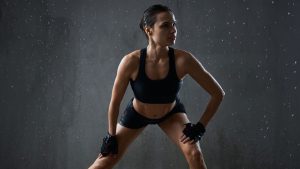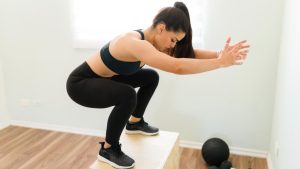Best Squat Variations for Injury Prevention in Female Athletes

Understanding the Importance of Squats
Squats are fundamental compound exercises that engage multiple muscle groups, including the quadriceps, hamstrings, glutes, and core. For female athletes, they’re invaluable for building lower body strength, enhancing athletic performance, and fortifying the muscles that support joints, reducing the risk of injuries.
Ideal Squat Variations for Injury Prevention
1. Goblet Squats
Goblet squats are excellent for athletes of all levels. Holding a kettlebell or dumbbell close to your chest as you squat down helps improve form and technique. This variation emphasizes proper hip and knee alignment, reducing the stress on vulnerable areas.
2. Split Squats
Targeting each leg individually, split squats aid in correcting muscle imbalances. This unilateral exercise enhances stability and helps address any weaknesses, which are common precursors to injuries.
3. Box Squats
Box squats involve squatting onto a box or bench, allowing for controlled depth and aiding in maintaining proper form. This variation minimizes excessive stress on the knees and helps build explosive power, crucial for athletic performance.

Considerations for Female Athletes
While these squat variations are beneficial for injury prevention, individual differences matter. Factors like prior injuries, mobility limitations, and specific sport demands should guide the selection of squat variations. Consulting a certified trainer or physical therapist can help tailor a program suited to your unique needs.
So.
For 28-year-old female athletes, incorporating squat variations into your training regimen is vital for injury prevention. Goblet squats, split squats, and box squats offer a well-rounded approach to building strength, correcting imbalances, and ensuring proper form. However, personalized guidance based on individual circumstances is key to maximizing the benefits while minimizing the risks.
Injury prevention is a crucial aspect of any athlete’s training routine, and these squat variations serve as foundational exercises to support your athletic endeavors.
The Role of Proper Form and Progression
Alongside selecting appropriate squat variations, ensuring proper form is paramount. Technique not only maximizes the benefits but also minimizes the risk of injury. Here are some key pointers:
1. Maintain Alignment
Focus on keeping your knees aligned with your toes, distributing the weight evenly through your feet, and engaging your core throughout the movement.
2. Depth Control
Avoid going too low if it compromises your form. Finding the right depth where you can maintain proper alignment is crucial to prevent unnecessary strain.
3. Gradual Progression
Start with bodyweight or light resistance and gradually increase intensity as strength and stability improve. Rushing into heavy weights can elevate the risk of injury.
Tailoring for Individual Needs
It’s important to recognize that not all athletes have the same requirements. Considerations should extend beyond just the selection of squats. Mobility work, supplementary exercises, and recovery strategies play integral roles in injury prevention.
Mobility Work
Addressing mobility limitations through stretching, foam rolling, or mobility drills can enhance range of motion, reducing the risk of strains or imbalances during squats.
Supplementary Exercises
Incorporating exercises targeting weak areas, such as hip stabilizers or core muscles, complements squat variations, ensuring a well-rounded strength program.
Recovery Strategies
Adequate rest, proper nutrition, and recovery techniques like massage or active recovery workouts are vital to prevent overuse injuries associated with intense training.
Final Thoughts
Injury prevention is a holistic approach that encompasses various facets of training and lifestyle. While squat variations form a cornerstone, a comprehensive strategy that includes proper form, gradual progression, personalized adjustments, and holistic care is essential for injury-free performance.
By integrating these elements into your training routine and seeking guidance from qualified professionals, you can optimize your workout regimen, minimize injury risks, and achieve peak athletic performance as a 28-year-old female athlete.
Remember, the goal is not just to prevent injuries but to foster longevity and sustainability in your athletic journey.
External Resources:
American Council on Exercise – Squat Variations
Women’s Health – The Best Squat Variations for Women
Physical Therapy and Rehabilitation Journal – Unilateral Exercises for Muscle Imbalances
Understanding the nuances of injury prevention and personalized training is key to unlocking your full potential as an athlete.
Comparison tabular
| Squat Variation | Benefits | Emphasis | Considerations |
|---|---|---|---|
| Goblet Squats | – Improves form and technique
– Emphasizes hip and knee alignment |
– Proper form and core engagement | – Effective for beginners and experienced athletes |
| Split Squats | – Addresses muscle imbalances
– Enhances stability and balance |
– Unilateral strength training | – Helps correct asymmetries and weaknesses |
| Box Squats | – Allows controlled depth
– Develops explosive power |
– Maintains proper form
– Builds strength without excess stress on knees |
– Focuses on power and controlled movement |
Summary of Squat Variations:
Goblet Squats:
Benefits: Improves form, emphasizes alignment, suitable for all levels.
Emphasis: Proper form and core engagement.
Considerations: Effective for beginners and experienced athletes.
Split Squats:
Benefits: Addresses imbalances, enhances stability.
Emphasis: Unilateral strength training.
Considerations: Corrects asymmetries and weaknesses.
Box Squats:
Benefits: Controlled depth, builds power.
Emphasis: Maintains form, develops strength.
Considerations: Focuses on power and controlled movement.
This table summarizes the primary advantages, emphasis, and considerations for each squat variation, providing a quick reference guide for female athletes considering these exercises for injury prevention.
Wrapping up
In the pursuit of injury prevention and athletic excellence, choosing the right squat variations plays a pivotal role for 28-year-old female athletes. Goblet squats, split squats, and box squats offer unique benefits, catering to different needs within a well-rounded training regimen.
Remember, while these variations serve as valuable tools for injury prevention, individual considerations, such as form, progression, and personalized adjustments, are paramount. Engage with certified trainers, physical therapists, or coaches to tailor a program that aligns with your unique physique, fitness level, and athletic aspirations.
Ultimately, injury prevention is about holistic care, encompassing proper form, gradual progression, complementary exercises, mobility work, and recovery strategies. By integrating these elements into your training routine, you can fortify your body, reduce injury risks, and pave the way for long-term athletic success.
So, embrace the power of squats, listen to your body, and craft a training plan that not only safeguards against injuries but propels you toward your athletic goals, ensuring a fulfilling and sustainable journey in sports and fitness.

Hey there, it’s Mike Rrsq, the Editor-in-Chief over at Jsquat.com, and I’m absolutely obsessed with all things squat fitness! I’ve been lucky enough to get some serious recognition for my work in this field. With a solid background in the fitness and wellness industry, I’ve been there right from the get-go, helping shape this website into what it is today.
You see, I’m not just the boss around here; I’m also a passionate contributor. I love sharing my insights through my articles, and trust me, they’re not your run-of-the-mill stuff. Each piece I write is a labor of love, filled with my expertise and real-world experience in the fitness universe. So, if you’re into fitness and looking for some inspiration, you’re in the right place!
Related Posts
- Should a 28-year-old female do back squat with pregnant
Back squats can be safe and beneficial during pregnancy for many women, including those who…
- Should female front squat harder than the back squat for glutes and tights
Front squats and back squats are both excellent exercises that engage various muscles, including the…
- Evaluating Your Back Squat Routine at 28
When you hit your late twenties, fitness takes on a new dimension. Amidst the bustle…
- Back Squat with a Shoulder Injury for a 23-Year-Old Male
When it comes to fitness and injuries, navigating the best approach can be challenging, especially…
- The 26-Year-Old Female Dilemma: Struggling with a 30kg Front Squat
Being in your mid-20s can be an exciting time filled with various personal pursuits, fitness…
- How Much Should I Squat If I’m 28 Years Old: Explained)
If you're a fitness enthusiast or someone looking to get into strength training, you may…
- Should a 28-year-old struggle with a 50kg Powerbag squat
At 28, many individuals are exploring fitness routines, seeking to push their physical limits, and…
- Should I do back squat if I am recovering from an injury
When recovering from an injury, especially one that affects your lower body or back, the…
